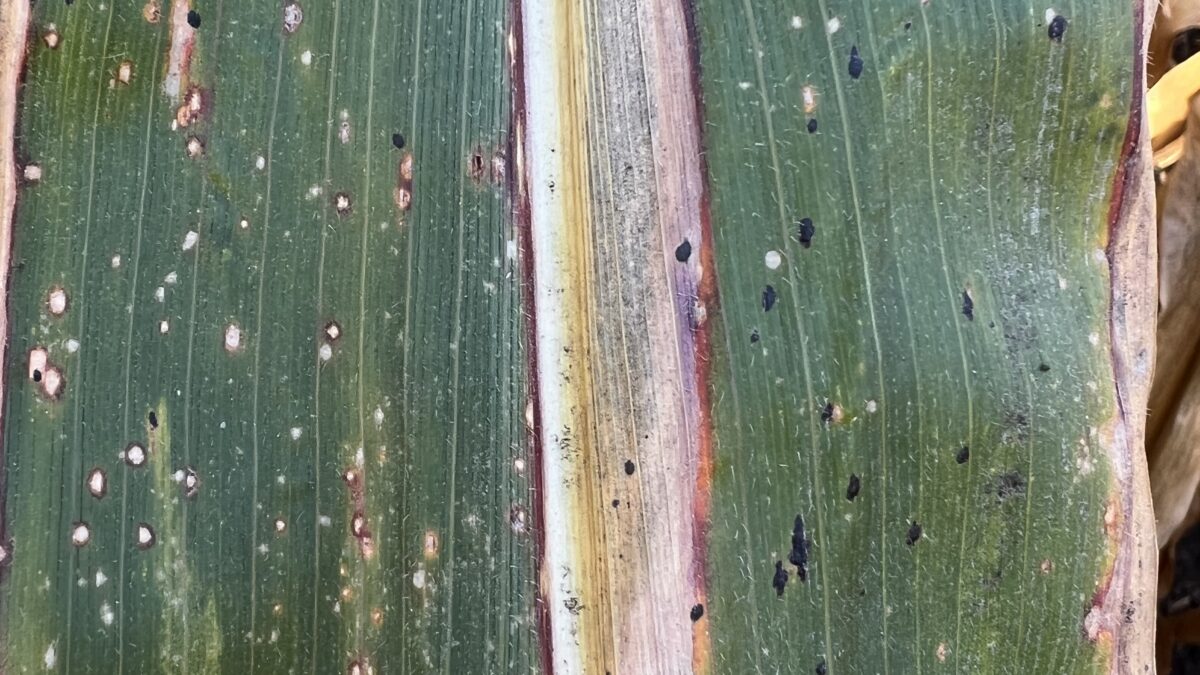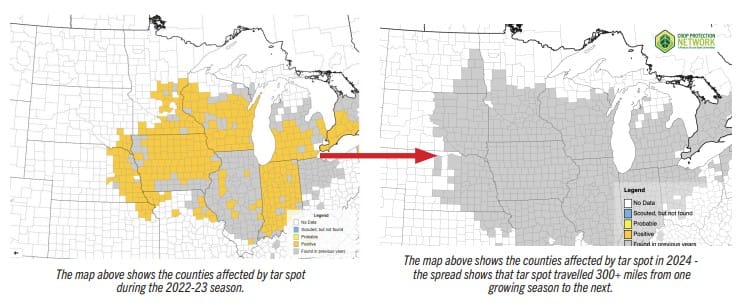Tar Spot Continues Its Journey North

First identified in Indiana in 2015, tar spot has steadily advanced across the country.
For the Peterson Farms Seed footprint, it’s notable that our eastern dealers, north of St. Cloud, Minn., first encountered the disease in 2021. Since then, they’ve seen it in three of the past four years, despite dry conditions. During the first couple of years only a handful of lesions were found. However, in 2024, with ideal conditions for development and more inoculum present, the disease flared up.
With the cool, wet and humid season 2024 brought, lesions were identified almost 300 miles west of where we had previously seen them. South Dakota State University reported tar spot is now present in every county east of the Missouri River. Similarly, North Dakota State University identified the disease in nine southeastern counties of North Dakota.
Recently, I had a chance to visit Dean Malvick, plant pathologist and program leader with the University of Minnesota Extension, and Andrew Friskop, plant pathologist with NDSU, about the disease and its progression. With such
quick movement across the country—spreading 300 miles in just one year—there is uncertainty about how far it can travel in a single season. It’s a safe bet anyone in the corn-growing areas of North Dakota, South Dakota and Minnesota has the potential to see it in 2025.
This is a concerning development for our region, which shares a similar climate characterized by cooler temperatures and higher humidity—conditions that favor tar spot development. In southern Ontario, near the eastern Great Lakes, growers have recently experienced yield losses of up to 100 bushels per acre due to tar spot in a similar climate.
Managing the Disease
Now that tar spot has arrived, the first step in managing it is identifying whether it is present in your fields. The Crop Protection Network is an online resource composed of resources and tools pulled together by Extension specialists and industry partners across the country.
Here you can find everything you want to know about the disease from identification to control measures. I encourage everyone reading this to become familiar with this site and explore its extensive disease management resources.
 The best time to start scouting for the disease is from V8 to R4. During this time fungicide control measures can be used to stop the spread. The critical optimum time to scout is V10 to R3 (milk stage).
The best time to start scouting for the disease is from V8 to R4. During this time fungicide control measures can be used to stop the spread. The critical optimum time to scout is V10 to R3 (milk stage).
With current low inoculum levels, the disease is unlikely to appear in June or July in our region. However, August and September may be ideal months for its emergence.
Yield losses are not expected in 2025. However, anything is possible now that tar spot is here. It’s essential to monitor and identify tar spot early to mitigate potential issues in 2026 and beyond.
As a seed company, we’ve prioritized hybrid selection to combat emerging diseases like tar spot. A decade ago, Goss’s Wilt spread rapidly and caught much of the industry off guard. However, through focused efforts, hybrid resistance to Goss’s Wilt has significantly improved, and today we offer hybrids with excellent resistance across our lineup.
The same approach is being applied to tar spot. In 2020, we had limited knowledge about hybrid resistance to this disease. Now, we have six hybrids in our commercial lineup with strong tar spot ratings. This progress ensures that when tar spot does appear in your fields, you’ll have resistant hybrids available to combat it effectively from the start.
Fungicides are also key! A single application can effectively control the disease in moderate- to low-pressure situations. Under high pressure, a second application may be needed. It is worth noting areas of southern Minnesota have already been applying up to two fungicide applications and seen yield increases of 20-50 bushels per acre.
The chart above (Figure 1) from the Crop Protection Network gives a great outline of how to handle the disease at each growth stage.
The Crop Protection Network also has an excellent “Foliar Fungicide Chart” to help select the proper chemistry. Fungicides groups or classes are much like herbicide groups in that they all have different strengths and weaknesses.
Single mode-of-action fungicides can be effective, but using a fungicide with up to three modes of action can stop the disease in its tracks. I recommend using this chart when selecting the proper fungicide.
Tar spot is a relatively new challenge, and there’s much more to learn. As we gain additional insights, we’ll continue to share updates.
Key Management Strategies
1. Hybrid selection: Choose hybrids with proven resistance to tar spot.
2. Fungicides: Properly timed fungicide applications with multiple modes of action can be highly effective.
3. Crop rotation: Although rotation can help, its impact may be limited due to the disease’s rapid spread, even under drought conditions.
4. Tillage: Incorporating crop residue into the soil can help break down infected material and reduce the spread of the disease.











